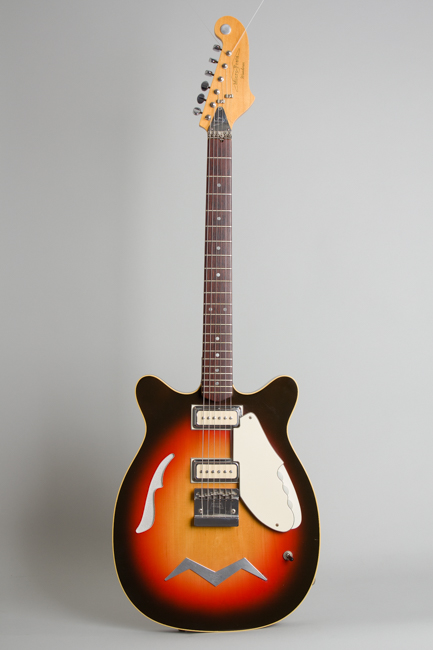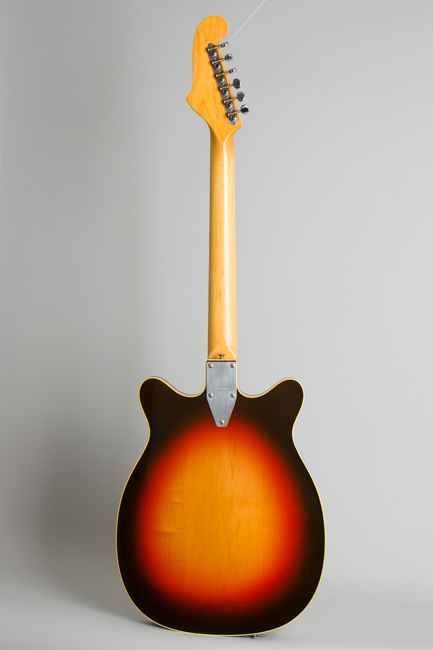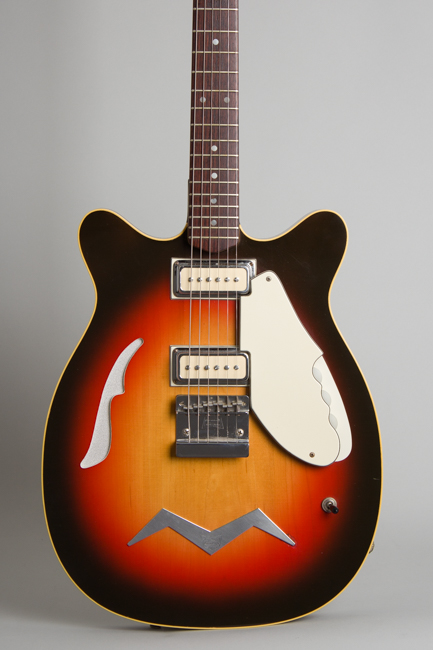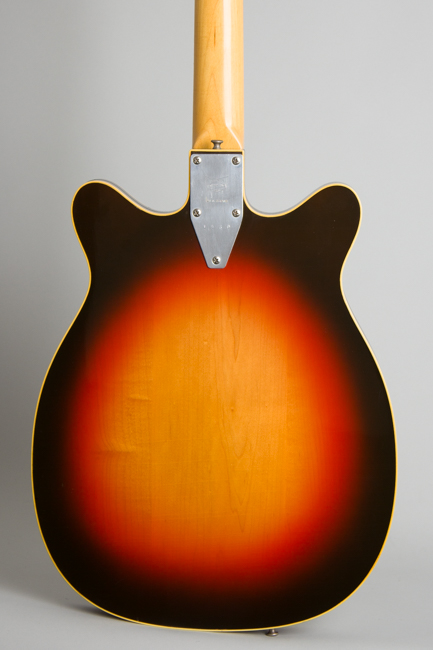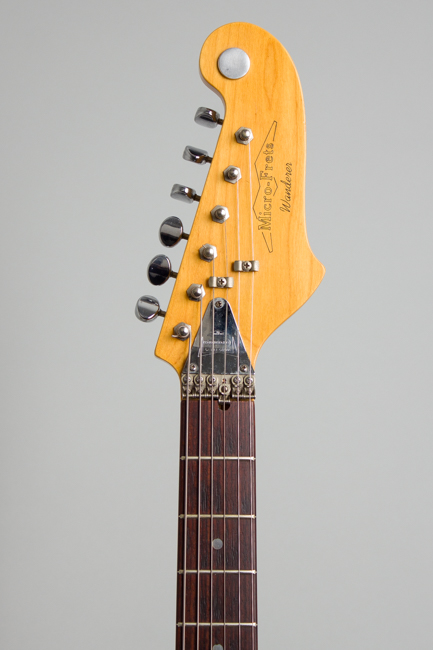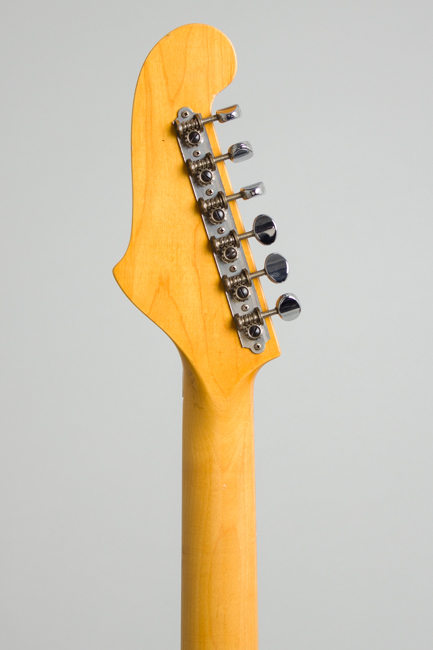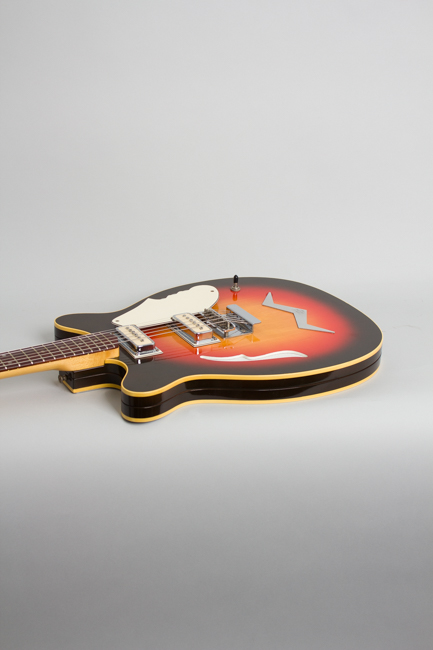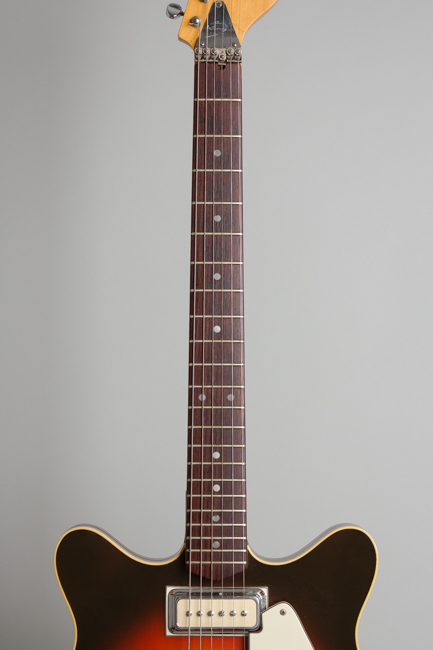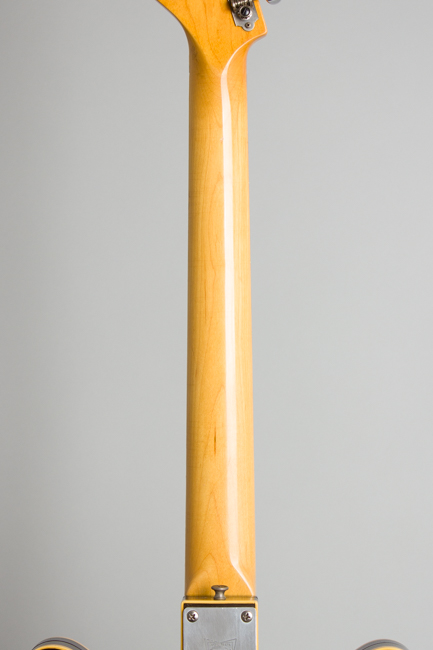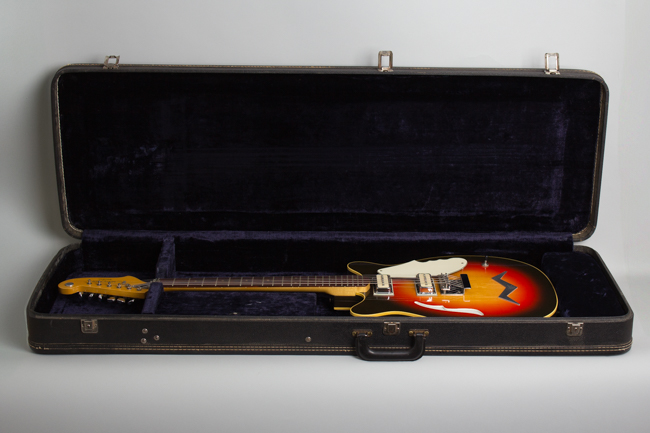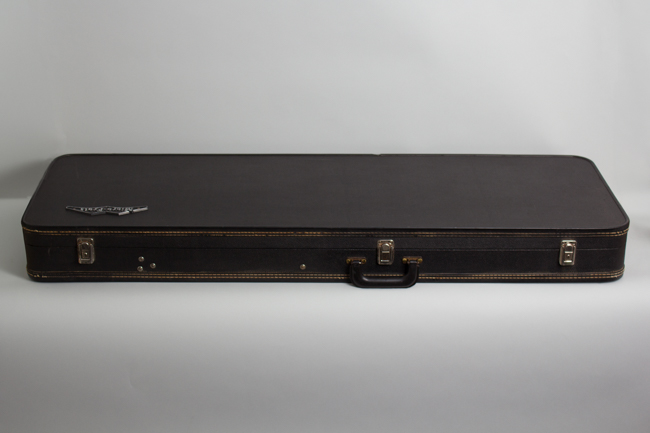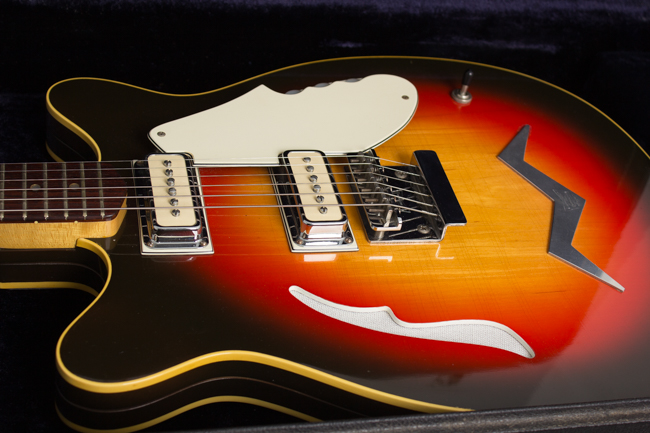Micro-Frets Wanderer Semi-Hollow Body Electric Guitar (1969)
Micro-Frets Wanderer Model Semi-Hollow Body Electric Guitar (1969), made in Fredrick, Maryland, serial # 1560, sunburst lacquer finish, maple body, maple neck with rosewood fingerboard, original black tolex hard shell case.
Some of the most unique and original American guitars of the late 1960s/early '70s came out of Frederick, Maryland, where the small Micro-Frets company built their beautifully engineered if decidedly offbeat fretted offerings. The line was the brainchild of one Ralph Jones, a self-taught engineer and inveterate tinkerer. Jones first perfected what he called the "Calibrato" vibrato unit in 1965, designed to enable individual tension adjustments for each string, theoretically allowing entire chords to be raised and lowered while remaining in tune. After failing to interest established manufacturers in the device, he went the next step and with financial help from his former employer started his own guitar manufacturing firm.
Micro-Frets was launched in 1967, by the following year the small factory was producing a fairly extensive line of utterly unique semi-solid electric guitars. Collectors have identified three major stages in their evolution from the earliest models through the company's demise in 1975, dubbed type 1, 2 and 3 depending on the construction and fittings. This instrument is a "Type 1-B" Wanderer, a semi-hollow body guitar with a two-piece maple sandwich body routed from the inside, with both halves clipped together but without the "Tempered Masonite" center gasket used on the earliest models. Micro-Frets serial numbers appear to start at either 1000 or 1100; in either case at #1560 this is a fairly early model, somewhat rarer than later pattern guitars.
Jones called this unusual construction the "Tonesponder" body; Micro-Frets rivals the UK's Burns firm in coming up with snazzy names for guitar parts. A universal feature of the company's instruments is the patented Micro-Nut, which allows harmonic compensation at the headstock and individual string height adjustments. This sits on a maple neck with an unbound rosewood fingerboard inlaid with simple pearl dots. The single-sided headstock is a swooping Fender/Bigsby inspired shape, fitted with openback Waverly strip tuners. The headstock has a decorative metal disc on the ball end, a brand logo and model name decal and a metal plate screwed on above the nut which appears redundant as the truss rod adjusts as the body end.
At the other end of the strings is a simple stamped metal tailpiece; this Wandered was built without the "Calibrato" vibrato unit at the heart of the Micro-Frets legend. It does substitute a large metal "M" logo plate on the lower body, waggishly dubbed the "seagull" by fans of the brand. The fairly heavy metal bridge is an improvement on the earlier Rickenbacker-inspired quadruped unit mounting on two rather stout pins adjustable for height. The saddles are adjustable for length; this earlier version does not use the knurled locking wheels added later.
The maple body is finished in a sort of Fender-y three-color sunburst. The spray work on this guitar is neater than some Micro-frets we have had, with very vibrant look to the 'burst. The two interlocking maple body halves are bound at the edges with a single stylized F-hole filled in with fabric. Two tone and a master volume for the twin pickups are carried laterally on the top-mounted pickguard, which is bi-level in the Rickenbacker mode with a triple laminate upper section; earlier "Style 1 " models had 4 of these rotary knobs. A selector switch is mounted to the body behind this. The pickups themselves are DeArmond single-coil units with adjustable poles; the next year Jones would perfect his own pickups with help from Bill Lawrence.
This early Wanderer (where was it supposed to wander to?) is a cool example of the factory's widely varied output, an eccentric but well-made and fine playing guitar with a slim comfortable neck and bright, responsive pickups. The sound is crisp and hi-fi with surprising depth when needed; the tonal range is impressive. "Micro-Frets: the Personal guitar" was the company slogan, highlighting the extensive adjustability of nearly every component. A number of prominent country artists endorsed Micro-Frets in the late 1960's including Carl Perkins, Buck Trent, Tommy Cash and the Statler Brothers. Micro-Frets had a fairly short history but the high-quality, well engineered instruments they left behind remain totally unique, fine examples of American guitar ingenuity and worthy of the attention of both players and collectors.
Overall length is 42 1/2 in. (108 cm.), 14 1/8 in. (35.9 cm.) wide at lower bout, and 1 5/8 in. (4.1 cm.) in depth, measured at side of rim. Scale length is 24 in. (610 mm.). Width of nut is 1 5/8 in. (41 mm.).
This sharp looking and easy playing guitar remains very clean and all original, showing only very light general wear overall. The finish on the body has some very fine checking and a few small dings and dents pretty much confined to the edges but really no serious wear. The top has one spot of light chipping around the treble side "wing" of the "seagull". The back of the neck is very clean except for a couple of tiny dinks along the treble side in the lower position.
The metal hardware has some light corrosion and wear marks here and there, most notable on the neckplate. The frets and fingerboard have hardly any wear and playability remains excellent. This is a fine example of a cool "Style 1 1/2" Micro-Frets in the original branded HSC which is a factory-reproposed bass case; they must have ordered more than needed and sent some out with guitars in them! Overall Excellent Condition.
Some of the most unique and original American guitars of the late 1960s/early '70s came out of Frederick, Maryland, where the small Micro-Frets company built their beautifully engineered if decidedly offbeat fretted offerings. The line was the brainchild of one Ralph Jones, a self-taught engineer and inveterate tinkerer. Jones first perfected what he called the "Calibrato" vibrato unit in 1965, designed to enable individual tension adjustments for each string, theoretically allowing entire chords to be raised and lowered while remaining in tune. After failing to interest established manufacturers in the device, he went the next step and with financial help from his former employer started his own guitar manufacturing firm.
Micro-Frets was launched in 1967, by the following year the small factory was producing a fairly extensive line of utterly unique semi-solid electric guitars. Collectors have identified three major stages in their evolution from the earliest models through the company's demise in 1975, dubbed type 1, 2 and 3 depending on the construction and fittings. This instrument is a "Type 1-B" Wanderer, a semi-hollow body guitar with a two-piece maple sandwich body routed from the inside, with both halves clipped together but without the "Tempered Masonite" center gasket used on the earliest models. Micro-Frets serial numbers appear to start at either 1000 or 1100; in either case at #1560 this is a fairly early model, somewhat rarer than later pattern guitars.
Jones called this unusual construction the "Tonesponder" body; Micro-Frets rivals the UK's Burns firm in coming up with snazzy names for guitar parts. A universal feature of the company's instruments is the patented Micro-Nut, which allows harmonic compensation at the headstock and individual string height adjustments. This sits on a maple neck with an unbound rosewood fingerboard inlaid with simple pearl dots. The single-sided headstock is a swooping Fender/Bigsby inspired shape, fitted with openback Waverly strip tuners. The headstock has a decorative metal disc on the ball end, a brand logo and model name decal and a metal plate screwed on above the nut which appears redundant as the truss rod adjusts as the body end.
At the other end of the strings is a simple stamped metal tailpiece; this Wandered was built without the "Calibrato" vibrato unit at the heart of the Micro-Frets legend. It does substitute a large metal "M" logo plate on the lower body, waggishly dubbed the "seagull" by fans of the brand. The fairly heavy metal bridge is an improvement on the earlier Rickenbacker-inspired quadruped unit mounting on two rather stout pins adjustable for height. The saddles are adjustable for length; this earlier version does not use the knurled locking wheels added later.
The maple body is finished in a sort of Fender-y three-color sunburst. The spray work on this guitar is neater than some Micro-frets we have had, with very vibrant look to the 'burst. The two interlocking maple body halves are bound at the edges with a single stylized F-hole filled in with fabric. Two tone and a master volume for the twin pickups are carried laterally on the top-mounted pickguard, which is bi-level in the Rickenbacker mode with a triple laminate upper section; earlier "Style 1 " models had 4 of these rotary knobs. A selector switch is mounted to the body behind this. The pickups themselves are DeArmond single-coil units with adjustable poles; the next year Jones would perfect his own pickups with help from Bill Lawrence.
This early Wanderer (where was it supposed to wander to?) is a cool example of the factory's widely varied output, an eccentric but well-made and fine playing guitar with a slim comfortable neck and bright, responsive pickups. The sound is crisp and hi-fi with surprising depth when needed; the tonal range is impressive. "Micro-Frets: the Personal guitar" was the company slogan, highlighting the extensive adjustability of nearly every component. A number of prominent country artists endorsed Micro-Frets in the late 1960's including Carl Perkins, Buck Trent, Tommy Cash and the Statler Brothers. Micro-Frets had a fairly short history but the high-quality, well engineered instruments they left behind remain totally unique, fine examples of American guitar ingenuity and worthy of the attention of both players and collectors.
Overall length is 42 1/2 in. (108 cm.), 14 1/8 in. (35.9 cm.) wide at lower bout, and 1 5/8 in. (4.1 cm.) in depth, measured at side of rim. Scale length is 24 in. (610 mm.). Width of nut is 1 5/8 in. (41 mm.).
This sharp looking and easy playing guitar remains very clean and all original, showing only very light general wear overall. The finish on the body has some very fine checking and a few small dings and dents pretty much confined to the edges but really no serious wear. The top has one spot of light chipping around the treble side "wing" of the "seagull". The back of the neck is very clean except for a couple of tiny dinks along the treble side in the lower position.
The metal hardware has some light corrosion and wear marks here and there, most notable on the neckplate. The frets and fingerboard have hardly any wear and playability remains excellent. This is a fine example of a cool "Style 1 1/2" Micro-Frets in the original branded HSC which is a factory-reproposed bass case; they must have ordered more than needed and sent some out with guitars in them! Overall Excellent Condition.
